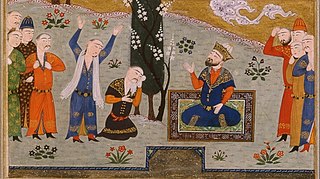
Imad al-Din Zengi, also romanized as Zangi, Zengui, Zenki, and Zanki, was a Turkoman atabeg of the Seljuk Empire, who ruled Mosul, Aleppo, Hama, and, later, Edessa. He was the namesake and founder of the Zengid dynasty of atabegs.

Ahmad Sanjar was the Seljuq ruler of Khorasan from 1097 until 1118, when he became the Sultan of the Seljuq Empire, which he ruled until his death in 1157.

Mughith al-Dunya wa'l-Din Mahmud bin Muhammad known as Mahmud II was the Seljuk sultan of Iraq from 1118–1131 following the death of his father Muhammad I Tapar. At the time Mahmud was fourteen, and ruled over Iraq and Persia.

Sultan Husayn Bayqara Mirza was the Timurid ruler of Herat from 1469 until May 4, 1506, with a brief interruption in 1470.
The Rai dynasty was a dynasty that ruled the Sindh region. All that is known about the dynasty comes from the Chachnama, a 13th-century Persian work about Sindhi history. Nothing particular is known about the first three kings—Rai Diwaji, Rai Sahiras I, and Rai Sahasi I. The fourth king, Rai Sahiras II, is said to have ruled over a vast prosperous area, including the seaport of Debal, divided into four provinces; he was killed in a conflict with the Sassanian King of Nimroz and lost territories around Makran. Rai Sahiras II was succeeded by Rai Sahasi II whose secretary, Chach, a Brahmin, usurped the throne after his death in connivance with Sohan Devi, the King's widow, and established the Brahmin dynasty. Sahasi II's relatives—Rai Mahrit, ruler of Chittor and Bachhera, the governor of Multan province—took on Chach, individually, but in vain.
The Samma dynasty was a medieval Sindhi dynasty which ruled the Sindh Sultanate from 1351 before being replaced by the Arghun dynasty in 1524.

Amīr ash-Shu‘arā’ Abū Abdullāh Muḥammad b. ‘Abd al-Malik Mu‘izzī was a poet who ranks as one of the great masters of the Persian panegyric form known as qasideh.

Jamal Fakir is a Moroccan rugby league footballer who plays as a prop or second-row for the Lézignan Sangliers club in the Elite One Championship.

The Apple Tree is a series of three musical playlets with music by Jerry Bock, lyrics by Sheldon Harnick, and a book by Bock and Harnick with contributions from Jerome Coopersmith. Each act has its own storyline, but all three are tied together by a common theme and common references, such as references to the color brown. The first act is based on Mark Twain's The Diaries of Adam and Eve; the second act is based on Frank R. Stockton's "The Lady, or the Tiger?"; the third act is based on Jules Feiffer's Passionella. The working title for the evening of three musicals was Come Back! Go Away! I Love You!
Mu'ayyid al-Din Ai-Aba was the amir of Nishapur from c. 1154 until his death. Although nominally subservient to the Seljuks of Khurasan, he acted as an independent ruler. Due to his control of much of Khurasan, the historian Ibn Funduq called him "Emperor of Khurasan, King of the East."

Nasir al-Din Abu al-Fatah Firuz Shah II, commonly known as Jam Feroz (1508–1524/5), was the last ruler of the Samma dynasty of Sindh. Jam Feroz proved himself a weak ruler and lost his kingdom to Arguns, thus Sindh came under foreign rulers.
The Battle of Fatehpur was a key episode in the dissolution of the Samma dynasty of Sindh and its replacement by the Arghun dynasty in 1519. The conflict between the Samma dynasty of Sindh and the Arghuns lead to the Battle of Fatehpur.
Sohrab Fakir Manganhar, also known as Sohrab Fakir, was a Sufi-singer from Sindh, Pakistan.
Jam Feruzuddin Al-Maroof Jam Unar bin Babinah was the first Sultan of Sindh. He belonged to the Samma dynasty, which ruled Sindh and parts of Punjab from 1351 to 1520.
Mian Sadik Ali Khan Kalhoro was a king of the Kalhora Dynasty that ruled Sindh.
Jam Mubarak Khan Qabulio Sammo also known as Darya Khan Lashari and Darya Khan Qabulio Sammo, was a general of the Samma Dynasty of Sindh, a statesman and regent at the court of Samma ruler Jam Feroz.

Cutch State, also spelled Kutch or Kachchh and also historically known as the Kingdom of Kutch, was a kingdom in the Kutch region from 1147 to 1819 and a princely state under British rule from 1819 to 1947. Its territories covered the present day Kutch region of Gujarat north of the Gulf of Kutch. Bordered by Sindh in the north, Cutch State was one of the few princely states with a coastline.
Ali I, was the ruler of the Bavand dynasty from 1118 to 1142. He was the uncle and successor of Rustam III.
Jam Raidhan was the 13th Sultan of Sindh. Historians have disparate views of Jam Raidhan; many have argued that Jam Raidhan and Jam Sanjar are different names for a single ruler of Sindh.

Shah Ghazi Rustam, was king of the Bavand dynasty of Mazandaran, ruling from 1142 to 1165. He expanded the borders of the kingdom at the expense of his neighbors, particularly the Ismailis and the Seljuks. He established a Bavandid presence in Gilan as a result of his frequent vengeful raids against the Ismailis, who had assassinated his son and heir, Girdbazu. He also brought Qumis and Ray under Bavandid control during his wars against the Seljuks and the Karakhanids.









